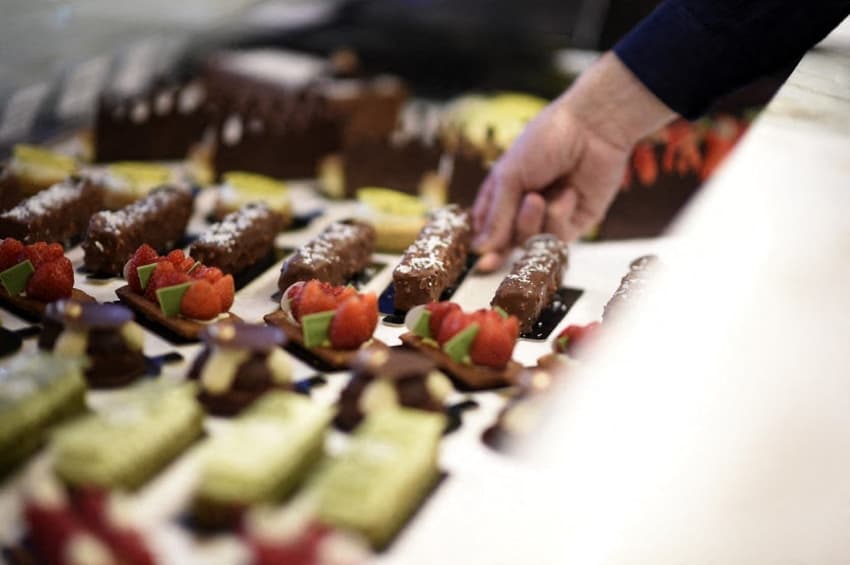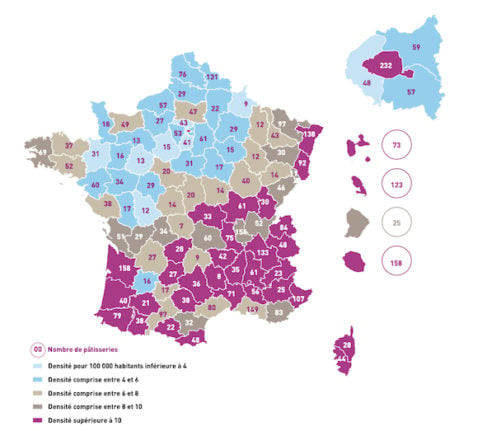5 things to know about French pâtisserie

Pâtisserie is so important in France that the average French household spends €350 a year on pastries, while the highly-respected pâtissiers have their own patron saint.
We know that baguettes are important to the French, who scoff an impressive 6 billion a year.
But while they often share a shop, the role of the boulanger (baker) and pâtissier (pastry chef) are very different.
Here's 5 thing you might not know French pâtisserie;
It is an multi-billion euro industry in France
There were over 33,000 bakery and pastry shops in France, and the sector employed over 180,00 people as of 2023, according to the national confederation of bakers and pastry chefs.
On average, for every 100,000 people in France, there are seven pâtisseries.
As of 2018, Paris (with 232 per 100,000) had the highest concentration of pâtisseries. Overall, however, the south of France had significantly more pastry shops than the north.

A screenshot of a graph produced by France's 'Observatoire des métiers'
As of 2018, 40 percent of French people said they bought pâtisserie at least once a week, with the average French household spending about €350 a year on pastries, according to Espace Concours.
The industry generates annual sales of around €11 billion.
Not all pastries are made from scratch on-site
French law states that the word 'boulangerie' (bakery) can only be used by artisans who "knead the dough, ferment and shape it, and bake the bread on site", but there is no legal equivalent for pastry-making.
As such, it is not uncommon to come across shops selling 'industrial' cakes and pastries - those either from pre-ordered kits or frozen materials.
A report by FranceAgriMer, cited by TF1, surveyed boulangeries-pâtisseries, finding that about half of respondents claimed they did not buy any pre-made or industrial pastries.
According to the confederation, the best way to ensure that pastries purchased were made on the premises is to seek out the 'fait maison' label, which has been awarded to over 1,000 pastry chefs across France.
READ MORE: Bio, artisan and red label: What do French food and drink labels really mean?
Becoming a pâtissier takes a lot of training
Those who work as pâtissiers have to get specific training.
First, they must complete a two-year course in order to acquire the 'CAP Patisserie' diploma. Oftentimes, this is done in vocational high school, but it can also be completed at apprenticeship centres.
Many pastry chefs opt to continue their educations and specialise in certain areas, like chocolate or ice cream. In order to do so, they must take classes - usually over the course of one year - to obtain a "Mention Complémentaire" (MC) in "Pâtisserie Glacerie Chocolaterie Confiserie Spécialisées".
Pastry chefs looking to gain the title 'Maître Pâtissier' (Master pastry chef) must stay in school for another degree, the "brevet technique des métiers pâtissier" (BTM).
This course typically takes about two years to complete, and it teaches pastry chefs management skills for self-employment. It is often a pre-requisite for applying to competitions, like the 'meileur ouvrier de France' (Best worker in France).
Professional pastry-making is still a male-dominated field
In France, there has been a long-standing tradition that men bake the pastries and women sell them.
However, that is starting to change. In 2023, Nina Métayer, a 35-year-old Frenchwoman from La Rochelle, became the first woman to win one of the world's most prestigious top pastry chef awards.
She was named the 'World Confectioner' by the International Union of Bakers and Pastry Chefs, an award that has been in existence for 92 years.
In 2021, Métayer gave an interview to the French media 20 Minutes where she said that “I take this role to heart, because it's important to show young women with dreams that, even if it's not easy every day, you can't give up and at least try to make them come true.”
While exact figures are hard to come by, in 2009 only 20 percent of bakers and pastry-makers were women in the PACA region in southern France. The trend is similar in the world of gastronomy - of the 44 new stars awarded in the 2023 Michelin Guide, only 10 percent were given to female chefs.
Nevertheless - more and more women are training to become pastry chefs: according to Huffpost, quoting the famous French gastronomy school, Ferrandi, there has been a 'notable increase' in the number of women enrolled in courses.
There is a patron saint of pastry chefs
Saint Honoré is the patron saint of bakers and pastry chefs.
Legend has it that hundreds of years ago, a man from Amiens named Honoré was elected to become a bishop, but the family nursemaid didn’t believe it. She was in the middle of baking bread for the family, and she supposedly said that she would only believe the news if the baker's peel she was using put down roots and turned itself into a tree.
The story goes that once the tool was put into the ground, it sprouted roots and eventually transformed into a mulberry tree (which bore fruit).
After hearing about the miracle, a Parisian baker then donated a plot of land to construct a church, which set in motion the bond between bakers and pastry chefs and Honoré.
May 16th is 'Saint-Honoré Day', also referred to as the 'fête du pain' - it's tradition on that day to buy a Gateau Saint Honoré, which is a ring of profiteroles filled with cream, on a pastry base and topped with a sweet glaze.
Comments
See Also
We know that baguettes are important to the French, who scoff an impressive 6 billion a year.
But while they often share a shop, the role of the boulanger (baker) and pâtissier (pastry chef) are very different.
Here's 5 thing you might not know French pâtisserie;
It is an multi-billion euro industry in France
There were over 33,000 bakery and pastry shops in France, and the sector employed over 180,00 people as of 2023, according to the national confederation of bakers and pastry chefs.
On average, for every 100,000 people in France, there are seven pâtisseries.
As of 2018, Paris (with 232 per 100,000) had the highest concentration of pâtisseries. Overall, however, the south of France had significantly more pastry shops than the north.

As of 2018, 40 percent of French people said they bought pâtisserie at least once a week, with the average French household spending about €350 a year on pastries, according to Espace Concours.
The industry generates annual sales of around €11 billion.
Not all pastries are made from scratch on-site
French law states that the word 'boulangerie' (bakery) can only be used by artisans who "knead the dough, ferment and shape it, and bake the bread on site", but there is no legal equivalent for pastry-making.
As such, it is not uncommon to come across shops selling 'industrial' cakes and pastries - those either from pre-ordered kits or frozen materials.
A report by FranceAgriMer, cited by TF1, surveyed boulangeries-pâtisseries, finding that about half of respondents claimed they did not buy any pre-made or industrial pastries.
According to the confederation, the best way to ensure that pastries purchased were made on the premises is to seek out the 'fait maison' label, which has been awarded to over 1,000 pastry chefs across France.
READ MORE: Bio, artisan and red label: What do French food and drink labels really mean?
Becoming a pâtissier takes a lot of training
Those who work as pâtissiers have to get specific training.
First, they must complete a two-year course in order to acquire the 'CAP Patisserie' diploma. Oftentimes, this is done in vocational high school, but it can also be completed at apprenticeship centres.
Many pastry chefs opt to continue their educations and specialise in certain areas, like chocolate or ice cream. In order to do so, they must take classes - usually over the course of one year - to obtain a "Mention Complémentaire" (MC) in "Pâtisserie Glacerie Chocolaterie Confiserie Spécialisées".
Pastry chefs looking to gain the title 'Maître Pâtissier' (Master pastry chef) must stay in school for another degree, the "brevet technique des métiers pâtissier" (BTM).
This course typically takes about two years to complete, and it teaches pastry chefs management skills for self-employment. It is often a pre-requisite for applying to competitions, like the 'meileur ouvrier de France' (Best worker in France).
Professional pastry-making is still a male-dominated field
In France, there has been a long-standing tradition that men bake the pastries and women sell them.
However, that is starting to change. In 2023, Nina Métayer, a 35-year-old Frenchwoman from La Rochelle, became the first woman to win one of the world's most prestigious top pastry chef awards.
She was named the 'World Confectioner' by the International Union of Bakers and Pastry Chefs, an award that has been in existence for 92 years.
In 2021, Métayer gave an interview to the French media 20 Minutes where she said that “I take this role to heart, because it's important to show young women with dreams that, even if it's not easy every day, you can't give up and at least try to make them come true.”
While exact figures are hard to come by, in 2009 only 20 percent of bakers and pastry-makers were women in the PACA region in southern France. The trend is similar in the world of gastronomy - of the 44 new stars awarded in the 2023 Michelin Guide, only 10 percent were given to female chefs.
Nevertheless - more and more women are training to become pastry chefs: according to Huffpost, quoting the famous French gastronomy school, Ferrandi, there has been a 'notable increase' in the number of women enrolled in courses.
There is a patron saint of pastry chefs
Saint Honoré is the patron saint of bakers and pastry chefs.
Legend has it that hundreds of years ago, a man from Amiens named Honoré was elected to become a bishop, but the family nursemaid didn’t believe it. She was in the middle of baking bread for the family, and she supposedly said that she would only believe the news if the baker's peel she was using put down roots and turned itself into a tree.
The story goes that once the tool was put into the ground, it sprouted roots and eventually transformed into a mulberry tree (which bore fruit).
After hearing about the miracle, a Parisian baker then donated a plot of land to construct a church, which set in motion the bond between bakers and pastry chefs and Honoré.
May 16th is 'Saint-Honoré Day', also referred to as the 'fête du pain' - it's tradition on that day to buy a Gateau Saint Honoré, which is a ring of profiteroles filled with cream, on a pastry base and topped with a sweet glaze.
Join the conversation in our comments section below. Share your own views and experience and if you have a question or suggestion for our journalists then email us at [email protected].
Please keep comments civil, constructive and on topic – and make sure to read our terms of use before getting involved.
Please log in here to leave a comment.